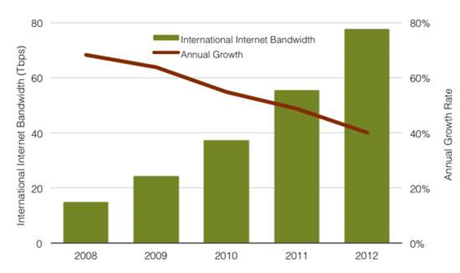TPG-owned Pipe International will bring a large increase in bandwidth to its PPC-1 subsea fibre optic cable between Sydney and Guam by adopting 100 Gbps equipment provided by Infinera.

Engineering manager Lee Harper said the driver for the upgrade is booming demand from existing customers in Australia and North America, who are buying more capacity as bandwith prices drop.
Harper said the cable system is proving popular with North American telcos who previously faced a large risk due to the high cost of bandwidth in Australia.
Thanks to the “price compression” introduced by PPC-1, the risk has halved, he said.
The upgrade will initially take the capacity of the two-fibre pair Pipe Pacific Cable from the current 200Gbps to 3Tbps, well in excess of its original design capacity of 2.56 Tbps delivered over 128 dense wavelength division multiplexed channels with 10 Gbps over each pair of fibre.
With further changes to the modulation scheme used for the optical transmission, Harper said PPC-1 will deliver 4-5 Tbps.
According to Harper, the equipment from Infinera is in transit and the upgrade will be in place by October 1 this year.
“There is no need to change anything at the repeaters, the only thing needed is new 500 Gbps Infinera cards in Sydney and Guam,” Harper says.
He wouldn’t reveal the exact cost of the upgrade, citing non-disclosure agreements, but said the expenditure would run into “several millions” of dollars.
Pipe will use Infinera’s DTN-X platform, which uses photonic integrated circuits or PICs as well as the FlexCoherent super-channels that comprise combined multiple optical carriers that can be managed as a single, 500 Gbps entity.
DTN-X was also selected for Pipe’s terrestrial network to multiple data centres in Sydney, with a total of 8 Tbps possible on a single strand of fibre.
Infinera deployed the DTN-X technology on 4500 kilometre of Pacnet’s C2C cable in May this year, to demonstrate the 500 Gbps super-channel technology.
The PPC-1 cable system was completed in October 2009 and spans 6900 kilometres with 78 repeaters from Collaroy Beach, Sydney, to Piti, Guam, with a spur to Papua New Guinea. It cost around US$200 million to build.
With current technology, the PPC-1 cable system is estimated to deliver over 10 Tbps.
Demand for international Internet capacity is at its slowest pace of growth for five years, thanks to slowing broadband growth in maturing markets and the expansion of local content delivery networks, according to analyst firm TeleGeography.
Even then, TeleGeography says global Internet bandwith reached 77 Tbps this year.
Mature markets won’t see triple-digit annual growth any more, according to TeleGeography research director Alan Mauldin. However, developing markets are likely to leave substantial room for growth.





.png&h=140&w=231&c=1&s=0)






 iTnews Executive Retreat - Security Leaders Edition
iTnews Executive Retreat - Security Leaders Edition












_(1).jpg&h=140&w=231&c=1&s=0)



